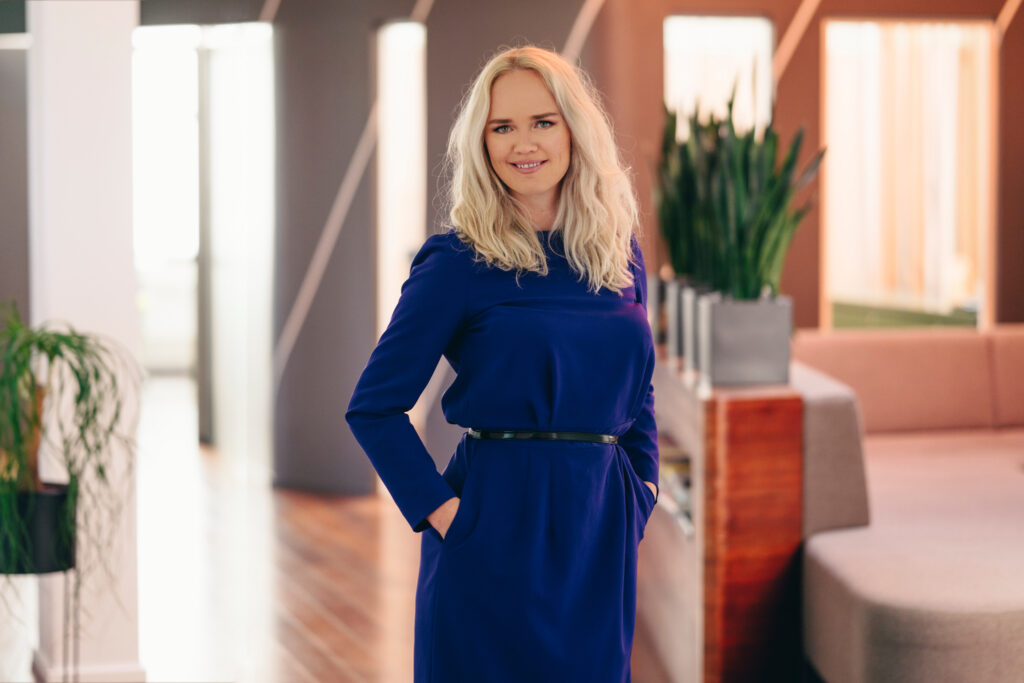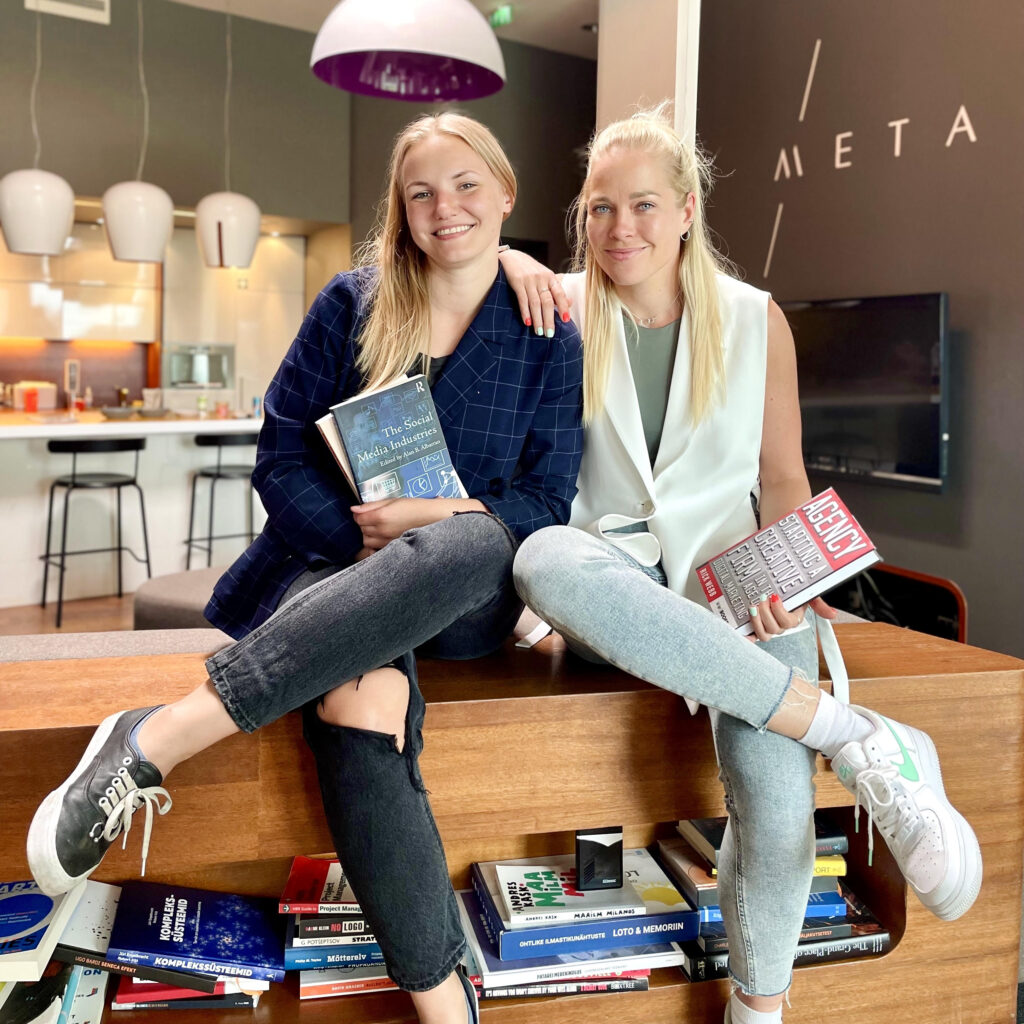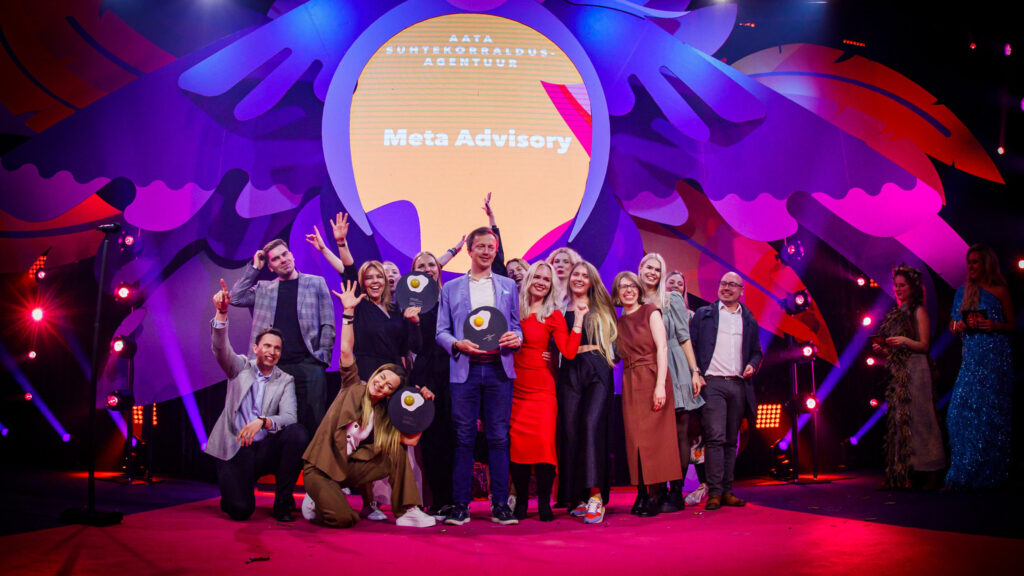Public affairs advisory firms Meta Advisory Group and Rud Pedersen Estonia merge
Rud Pedersen Group (RPG), Europe’s largest public relations and communications firm, has acquired a stake in Meta Advisory Group (META) and the transaction will merge META and Rud Pedersen Estonia. As a result of the transaction, META will become part of Rud Pedersen Group. The company, which operates in 13 countries, has nearly 500 employees, 75 partners and hundreds of cross-border clients.
“Rud Pedersen Group has emerged as the best public relations firm in Europe because of its ambitious management team, culture of getting things done and entrepreneurial spirit. These are the same characteristics that have enabled META to grow to the same status in its home market. Rud Pedersen’s culture and outlook match our own – a drive to succeed, transparency in relationships and a straightforward working and consulting style, a safe working environment – which enables people to work under with high responsibility and pressure and achieve results. For our clients, the transaction has clear benefits – in the Baltic business region and the three capitals alone, we are now one team of a hundred consultants and experts supporting our clients across the entire communications spectrum – from government relations to reputation management, from brand and digital communications to crisis communications,” said Andreas Kaju, Managing Partner at META.
Morten Rud Pedersen, founder and chairman of the board of Rud Pedersen Group, saw the deal as an opportunity to take a market-leading position across the Baltic region.
“We warmly welcome new colleagues to our group! We have now managed to bring together the market leaders of the Baltic States into one team and this is the kind of competitive advantage we want to offer our customers across Europe. META’s approach to advising its customers on both policy-making and public communication is straightforward, pragmatic and transparent in its relations with each other and with society. This fits very well with the Nordic heritage and culture of our group. Together, we are doing great things for Estonian and international businesses!” says the Group President.
Kairi Uustulnd, until now head of Rud Pedersen Estonia, will take over as head of META’s government relations team. Ann Hiiemaa will continue to lead the marketing communications team and Rainer Laurits will continue to lead the reputation team. Ott Lumi will take on the role of Special Adviser for Government Relations, where he will continue to lead several of META’s strategic projects.
“At Rud Pedersen Estonia, we have so far focused purely on government relations. It has been a very natural development for us, that by strategically expanding our services, we have chosen the best experts on the market not only based on their skills but also on the basis of their entrepreneurial culture. The merger with the Meta Advisory team expands the value proposition for the clients of both companies – in the synergy of two strong teams, we will continue to offer both local expertise and international experience,” says Kairi Uustulnd.
The company shall continue to operate as Meta Advisory Group in Estonia.
Meta Advisory Group (META) is part of the Rud Pedersen Group (RPG). META is headquartered in Tallinn, Estonia, and its three teams – Government Relations, Marketing Communications and Reputation Management – advise Estonian and international business organisations, non-profit organisations as well as Estonian public sector projects across the entire spectrum of public relations and communications services. Founded in 2003, RPG is headquartered in Stockholm and has almost 500 consultants and 75 partners working in 13 markets around the Baltic Sea and Europe.
5 most common mistakes people make on LinkedIn
LinkedIn has long been a well-known platform for recruiters and job seekers. Still, in recent years, the platform has gained popularity among business people looking to build their credibility, develop a personal brand and share ideas about their work field. However, the growing amount of content also brings typical mistakes into sharper focus. What are the most common mistakes on LinkedIn content creation, and how to avoid them?
Companies encourage employees to share company news on personal LinkedIn accounts to build employee advocacy. This is a justified tactic, as employees’ posts attract eight times more views and engagement on the platform than corporate (i.e. official company account) posts.
Unfortunately, many organizations have not yet taken the opportunity to create brand ambassadors on LinkedIn or given their employees the knowledge and resources to make the most out of their profiles. However, poorly thought-out content is created without understanding the basics of the platform. The mistakes can lead an individual or company further from their ultimate goal and reduce users’ trust.
5 MISTAKES TO AVOID:
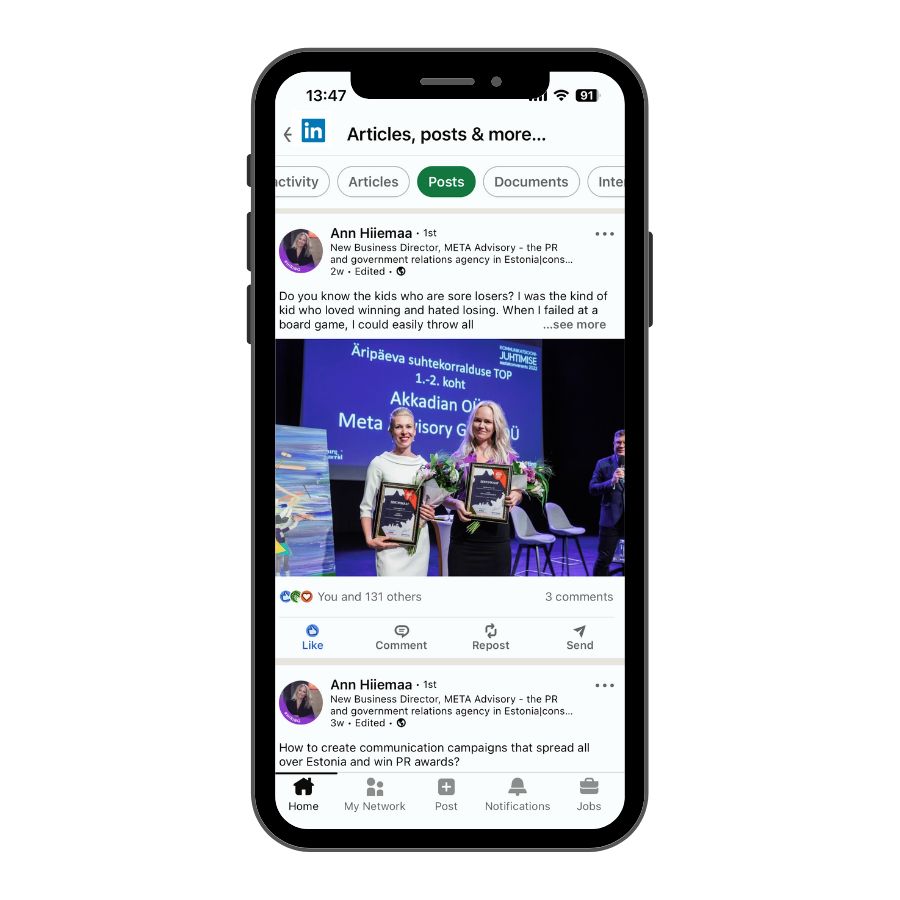
1. Not setting a goal
LinkedIn is used for various purposes: finding investors, expanding social networks, building a personal brand, staying up to date with industry news, and finding work partners. It is easier for ambassadors to get the most out of the platform if their aim is precise and they know where they are going with their profile. Take time to think about why you chose to create an account and how to support your career building.
2. Targeting the wrong audience
Targeting is the basis of almost all marketing activities. We need to know our audience to create hard-hitting messages that will help address the pain points of our intended audience. LinkedIn allows us to get as specific as possible with our target audience, explore different profiles and identify the issues that people in a particular field or sector might have. Defining the audience is also essential for expanding your list of connections – if the goal is to find investors, there’s no need to add engineers who are unlikely to be interested in the content you share.
3. Unfinished profile
On LinkedIn, it is possible to distinguish between passive and proactive content. While proactive content refers to posts one creates on a profile, passive content can be defined as all the information on a user’s profile relevant to the target audience – from the cover photo to work experience. For many, a profile is the equivalent of a CV, but this is not quite the case.
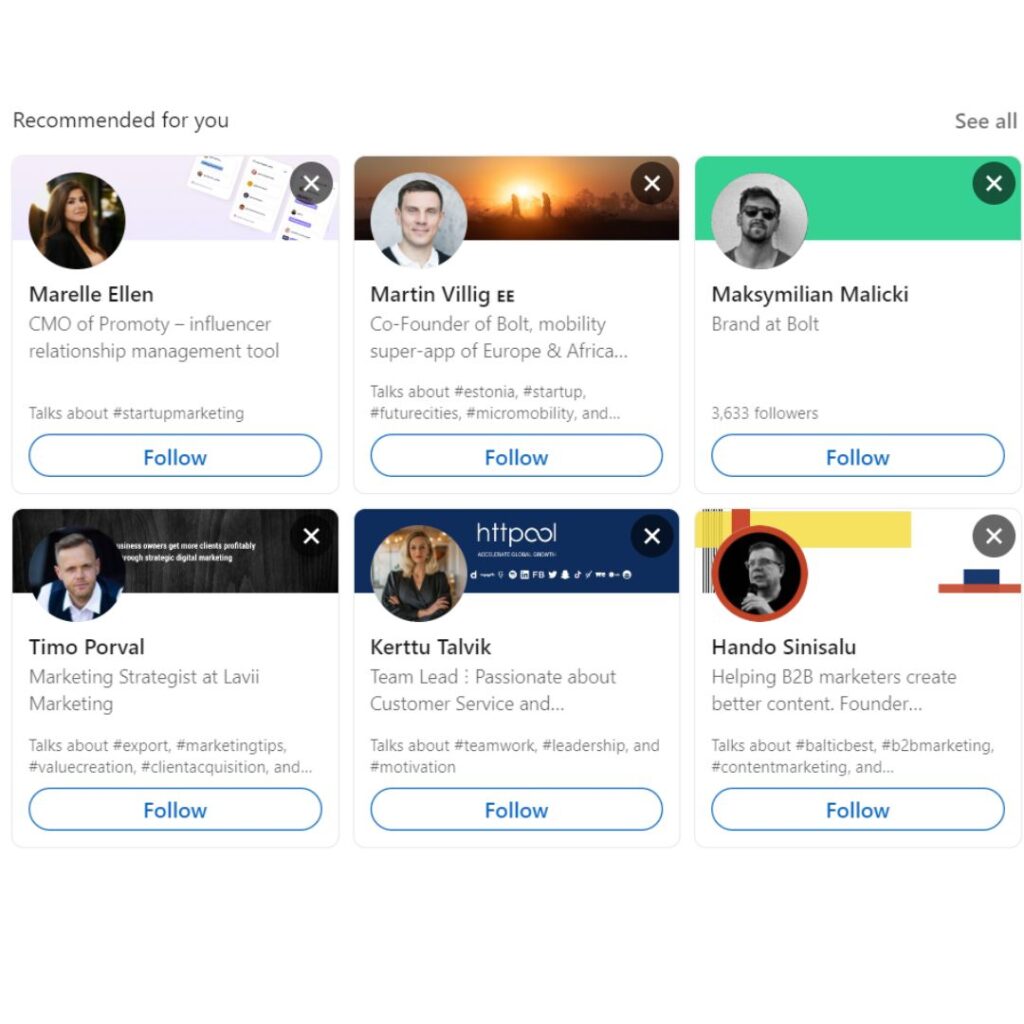
A profile allows everyone to tell their story and speak to their target audience without being too pushy or sending private messages. The critical elements of a profile are the headline and about sections, which describe to the target audience exactly how the profile owner helps them, gets results for them, and what are the person’s principles and processes.
4. Lack of a supporting message in posts
Anyone, who has spent a bit of time on LinkedIn, has probably come across posts that seem too vague or lacking in content. While many LinkedIn marketers recommend focusing on quantity, or the abundance of posts, to increase visibility, this can also harm a profile owner, as such content can become tedious and superficial for followers.
If you aim to build a strong personal brand, take time to create meaningful posts, check out the trends in your field, and plan your steps well in advance. It can also be worthwhile for beginners to show their first posts to friends or colleagues – take their honest feedback into account and make the necessary changes before publishing the post.
5. “Connect” vs “Follow” button
One of the latest trends on LinkedIn is converting a regular user-type account into a content creator-type profile. This means that the “Connect” button on a person’s account becomes a “Follow” button instead. It makes sense for content creators with a broader audience to switch from “Connect” to “Follow” to avoid drowning in a sea of friend requests. However, accounts with a smaller following should seriously consider this decision before using the button. On LinkedIn, the connect button lets both parties keep up to date with each other’s news and activities, thus expanding their social circle.
How to make redundancies without damaging people and the company’s reputation?
A total of 52,000 people in the US tech sector have been made redundant. In Estonia, 17 companies have given collective redundancy notices. How can we communicate redundancies in a way that does not hurt the company and its people?
Making people redundant is probably not a pleasant thing for any company. How redundancies are carried out affects not only the current and future employees of a company but also its reputation.
It is essential to understand that the link between a worker and the company continues after the moment of redundancy. How a company treats its people speaks volumes about its leaders, culture and values.
Internal communication: be respectful
Before communication, getting the inevitable redundancy right is important. Key is in valuing people’s previous contribution to the company and, where possible, advising them on their future career path (leaving the company, looking for a new job – from letters of recommendation, if justified, to engaging paid consultants). Given the impact of redundancies on the organisation, both internally and externally, such costs should not be feared. It is better to do away with the company summer days than the activities mentioned above.
We have experience with companies which, having been forced to make redundancies, have found new jobs for each person affected by that decision. This activity speaks much more about the values and culture of the company than the words on its website. However, in the case of large companies, this is often not possible for obvious reasons. Still, humane and personalised communication should be within everyone’s abilities.

Internal communication: timing is key
Information spreads fast. During redundancies, priority must be given to existing employees. However, they aren’t always the first to hear about redundancies in their company. This is where both corporations and small businesses make mistakes. Most recently, for example, an internal memo of Ford, which made 3000 people redundant, was leaked.
Suppose the redundancies are significant, for example, more than 10% of the workforce of a large organisation. In that case, the first thing to do is to communicate it to the whole organisation. What the managers have decided and why, how the redundancies will be carried out, what processes have been developed to deal with the situation, and what opportunities the company offers to those made redundant. This is important to avoid speculation. It will also give remaining colleagues guidance on how to deal with departing colleagues. So that they can look at each other in the corridor, be supportive of redundant colleagues and help with finding solutions.
In terms of communication, broader reporting of redundancies is also important regarding information leakage. Leaks are going to happen anyway (listed companies are, of course, obliged to disclose the information to the stock exchange first if it is a decision with a significant economic impact), and an internal memo humanely describing and explaining the whole process is the best way to control your message. A good example is a memo sent by Patrick Collisson, CEO of technology company Stripe, to his colleagues on 3 November.
While people have been recruited remotely and via Zoom calls over the past two or three years, the same channel should be avoided to communicate the redundancy message. An employee should get this information in a physical meeting. The more one-to-one meetings that can be held, the better for the people themselves and the company. It is essential to leave room for dialogue between the employee and the employer and to convey the information as honestly as possible. People should not be left with the impression that they are to blame for mass redundancies. That is the difference between redundancy and dismissal (although it is also worth making dismissals in a way that helps people to better realise their potential in the future).
Often the size of the company makes it impossible to have one-to-one conversations, but if attainable, you should try to do so. It can also reduce the risk of people venting their displeasure on LinkedIn or other social media. We probably all remember the companies that made hundreds of people redundant on a Zoom call during the pandemic. Undoubtedly, recruiting talent will be more difficult for them in the future.
External communication: who are the target audiences, and how should they hear the news?
It is not only existing employees who will be affected by the redundancy announcement. Identifying the stakeholders who will also be affected by the information is important. A communication plan to implement the redundancies and clear and specific messages to each stakeholder group will help avoid panic.

Communicating redundancies should be treated similarly to crisis communication – information must be based on facts. Lies, obfuscation and cover-ups will come out sooner or later and can damage the company for years. Consideration must also be given to the employees remaining in the company. It is important to send them a message about how the company is overcoming the crisis.
Preparing the management
No CEO wants to be seen as a bad person during a redundancy period. For company leaders to be prepared to carry out redundancies credibly. A strong and specific message that empathises and puts the people being made redundant at the centre of attention, rather than the managers themselves, can make the process less painful.
Talking about redundancies in person with team members is undoubtedly difficult for the manager. Most people don’t like to put themselves in a potentially conflictual situation. Communicating the dismissal decision is not easy for the manager, regardless of how thorough the preparation is. However, it should not be forgotten that it is an even more negative experience for the person being made redundant. It is up to the company to decide whether the experience is traumatic, whether they explain the reasons for the difficulties the company is facing, and whether it is possible to help and support the redundant person in readjusting his or her life and finding a new job.
Humane chats and support services will not make the redundant worker happy, and they might not understand the motives behind the managers’ decisions for some time. However, after a few months or a year, when the feelings have subsided, most will realise that the process could have been handled much worse, and the actions at critical moments by people and the companies they lead will, in hindsight, be seen through a different lens.
While redundancies are painful for any business, they can be mitigated through thoughtful communication. Avoiding basic mistakes and preparing company spokespersons for external and internal communication.
What to remember when communicating redundancies:
- Communicate the redundancy face-to-face, not via a Zoom call or email.
- Communicate a clear vision of the following processes and what the company plans to do to emerge from the crisis.
- Be clear in your communication – what will change for those who remain in the company and what steps must be taken by those who are being made redundant. And above all – how will the company support them going forward?
- Prepare the company’s management for internal and external communication. Think about specific messages for each segment.
How to really build a personal brand?

A personal brand is not something that can be artificially created and cultivated. For a personal brand – only authenticity works. Who are you as a person? Who are you as a leader? What are your values? What do you have to say to your followers?
Estonia has only 1.3 million people, and creating a solid personal brand is much easier here than in Silicon Valley, London or Berlin. Yet, for us introverted and shy Estonians, it’s more complex than for others.
As Estonians, we want our work to speak for us. We don’t want to brag about our triumphs or talk openly about our failures or burnouts. If somebody notices us, that’s good; if they don’t, we need to work harder.
Unfortunately, it doesn’t work like that in today’s world anymore. To succeed, you need to build your own personal brand and network to get your message across to the people who matter – potential customers, employees or even investors. A strong personal brand can be the key to business development, recruitment and company growth. But it all needs to be strategically managed.
“A personal brand is not just about self-promotion or being visible online and at conferences.”
Where do you start to build a personality brand?
1. Start with yourself. A personality brand is what people say about you when you haven’t even entered the room yet. What do you want to be known for in particular? A personality brand is not just about self-promotion or being visible online and at conferences. It starts with how you define yourself as a person and what your values are. Creating a personal brand takes work. You need to be knowledgeable in something. Positioning yourself as an expert is hard, and it starts with the question: what am I an expert in? Think about what you want to communicate to people. Why should they believe you? What results have you already achieved?
2. Who is your audience? It would help if you could define as precisely as possible the target audience that you want to reach first. Are they marketing managers, engineers or developers? Once you have defined the audience you want to reach, consider the most effective channel to get to them. Is it strong opinion pieces in traditional media, conferences, inspiring speeches at universities, LinkedIn posts, or all of the above? Whatever you do, don’t forget that artificial speeches don’t give results. Be genuine! Real people’s real stories – even the missteps and mistakes. Dare to talk about them.
“BE HONEST! REAL PEOPLE’S REAL STORIES, EVEN THE MISSTEPS AND MISTAKES. DARE TO TALK ABOUT THEM. ”
3. What is your story? You have been living it even if you haven’t consciously created your narrative. If you’re out of the room, you can guess what people say about you. “They’re an extremely charismatic entrepreneur,” “They’re a great project manager”, or “They’re a genius who creates the best advertising campaigns in our region.” If you don’t consciously create your brand, other people will do it for you. A one-minute pitch or elevator speech is not only important for start-ups. It helps the audience understand your impact and strengths. Develop a clear and concise self-introduction, explaining who you are and how your past skills relate to your current work. What is your mission? What do you value as a person?
4. You create your brand every day. The truth is that everything you do is visible to other people in some way. Whether in real life or online, it affects your personal brand. Treat everyone with equal respect, regardless of their position – be it customer service or CEO. Estonia is too small to be rude to those with nothing to offer you.
META Advisory is Estonia’s most successful public relations company

Äripäev’s annual conference on communication management has recognised the best public relations companies in Estonia, and META Advisory shares the top spot this year with Akkadian.
According to Andreas Kaju, founder and partner of META, the agency’s success is based on its comprehensive communication management and execution approach. META has a culture of impact, success, cohesiveness and collaboration. “What sets us apart from other agencies is our unrivalled regional value proposition – META Advisory teams in other Baltic countries and a strong network of partners,” said Kaju. “We approach our clients through a very hands-on advisory approach. Our processes are well thought out, our teams have strong competence, and we apply client relationship management principles that enable us to deliver the financial performance that the business environment allows at any given time, year after year,” he said.
“META HAS A CULTURE OF IMPACT, SUCCESS, COHESIVENESS AND COLLABORATION.”
That’s why META has people who, besides having a broad reach, also have specific competencies or long experience and domain knowledge in one or another business area – food and beverage, financial services, medical and healthcare, technology and start-ups. “In addition, we have people with specialized skills and knowledge in technical professional areas such as personal branding and LinkedIn campaigns, digital marketing bootstrapping, reputation architecture, crisis management, etc.,” Kaju highlighted.
META Advisory would like to thank its clients who have trusted us as partners and encouraged us to evolve continuously. “Only with you can we successfully solve complex communication challenges and projects,” said Kaju.
See the full ranking of the TOP PR firms with in-depth comments from the winners HERE.
Five tips to get to the heart of Gen Z through effective communication
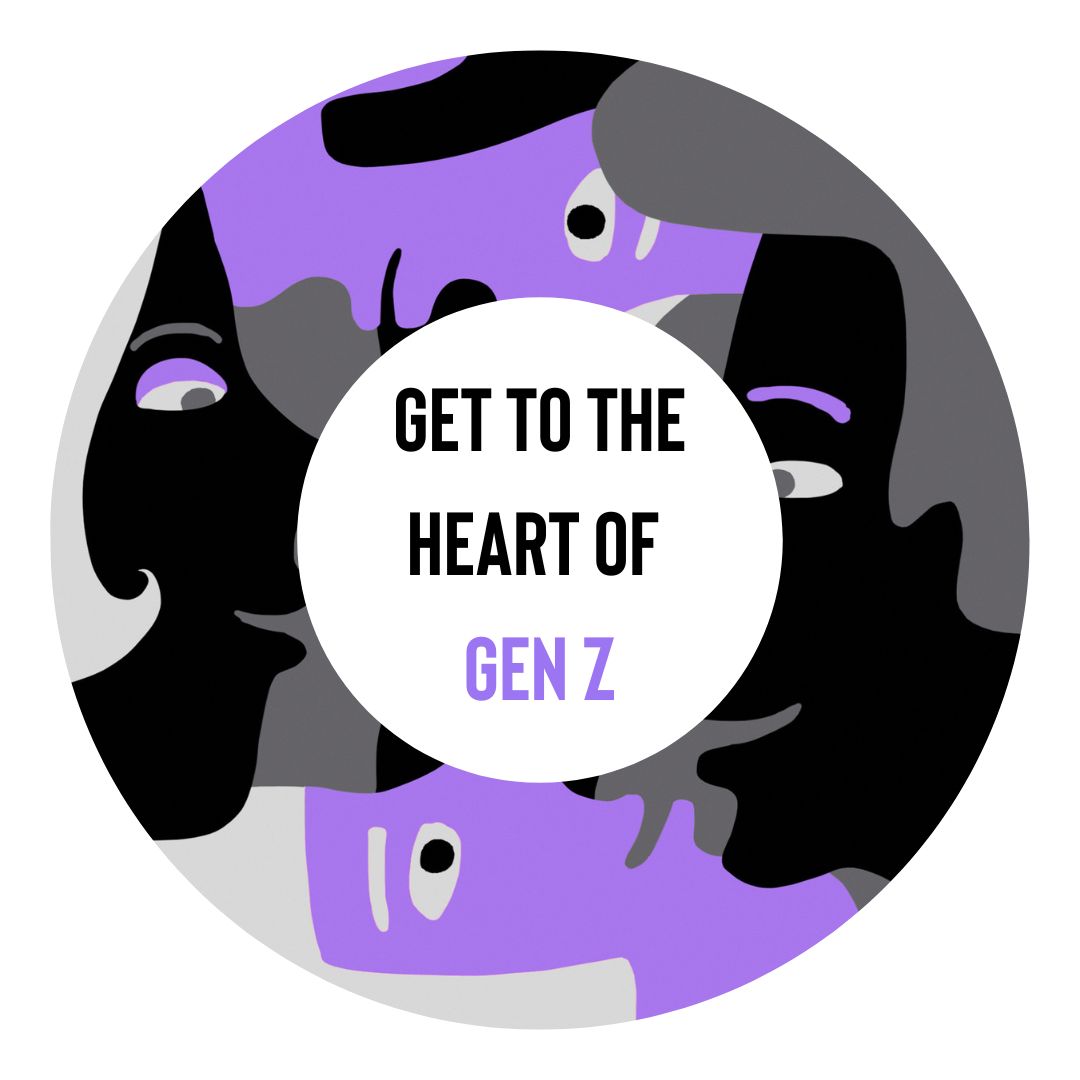
With every year, Generation Z makes up a larger share of the population with purchasing power. To win their loyalty, you need to start targeting them now.
Who is Gen Z?
Gen Z is characterised by openness, high technological awareness and a global perspective.
Gen Z is commonly defined as people born between 1997 and 2015. They are characterised by a constant orientation towards the virtual world, with an increasing emphasis on community. The community, be it, influencer followers, social media groups or even forums, is increasingly guiding their consumption decisions. As a result, Gen Z is strongly connected to ‘its clan’, based on shared values, experiences and worldview.

The interactivity of social media allows young people to ask each other for advice and constantly share their views. Gen Z is socially inclined and can quickly acquire knowledge and learn new skills.
Why is Gen Z important?
Young people are becoming an increasingly large part of the purchasing population. What’s more, Gen Z already has more purchasing power than previous generations at their age. One of the reasons for this is that Gen Zers are entering the workforce at younger age. It should be remembered that when marketing a brand, it is necessary to reach potential consumers as early as possible. The earlier we reach Gen Z, the more likely young people – both now and in the future – will want to be associated with a brand they identify with and believe in.
Companies and institutions that are forward-thinking and involve young people in developing marketing strategies will have an advantage.
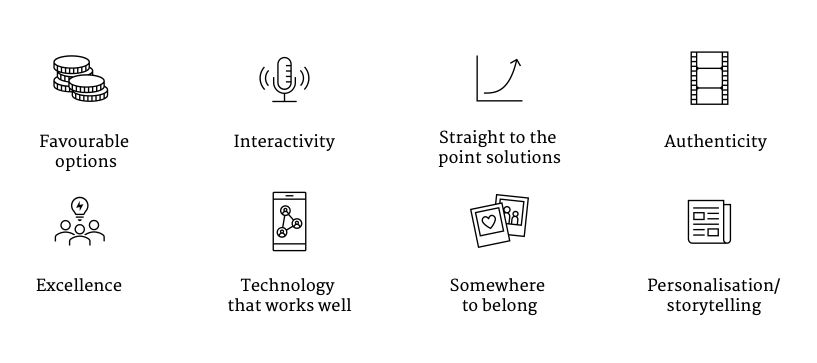
How do you communicate to Gen Z?
To reach young people, you need to be in the same information space as Gen Z, know the unwritten rules of social media, and stay on top of ever-changing trends. The most important thing is to your communication to be:
- Concrete. Gen Z’s attention spans fade quickly, so there’s little time to win it. You need to be able to deliver your message in just a few seconds or be able to generate interest for them to stay longer.
- Outstanding. Amidst the constant information noise on social media, you need to stand out and evoke emotion in Gen Z.
- Sincere. Gen Z is used to consuming mind-boggling amounts of information, so young people have a good nose for authenticity. They can see through vague talk and promises and are not afraid to call it out.
“Companies and institutions that are forward-thinking and involve young people in developing marketing strategies will now have an advantage.”
It is essential to understand that Gen Z not only consumes information but also creates it. A successful communication strategy can initiate a discussion that allows Gen Z to identify with the proposed topic, share their opinions and pull the entire virtual space along with them.
Five tips to get to the heart of Gen Z:
- Create a concrete and specific message.
- Collaborate with the right influencers – find people in a similar age group, popular within the target audience, and who are trusted or known.
- Speak up on current issues and be active in promoting your brands values.
- Pay attention to user experience, too – nothing embarrasses Gen Z more than a cluttered website and bad internet.
- Use interactive and innovative solutions. Gen Z’s attention span is quickly distracted, so it’s essential to engage them from the first moment and make them feel like they’re a part of the promotion.
Meta team
Nele Leit-Teetlaus Intern
Georg-Marten Meumers Intern
Meta team
Kätriin Avarlaid Intern
Three Questions x META Digital Marketing Experts
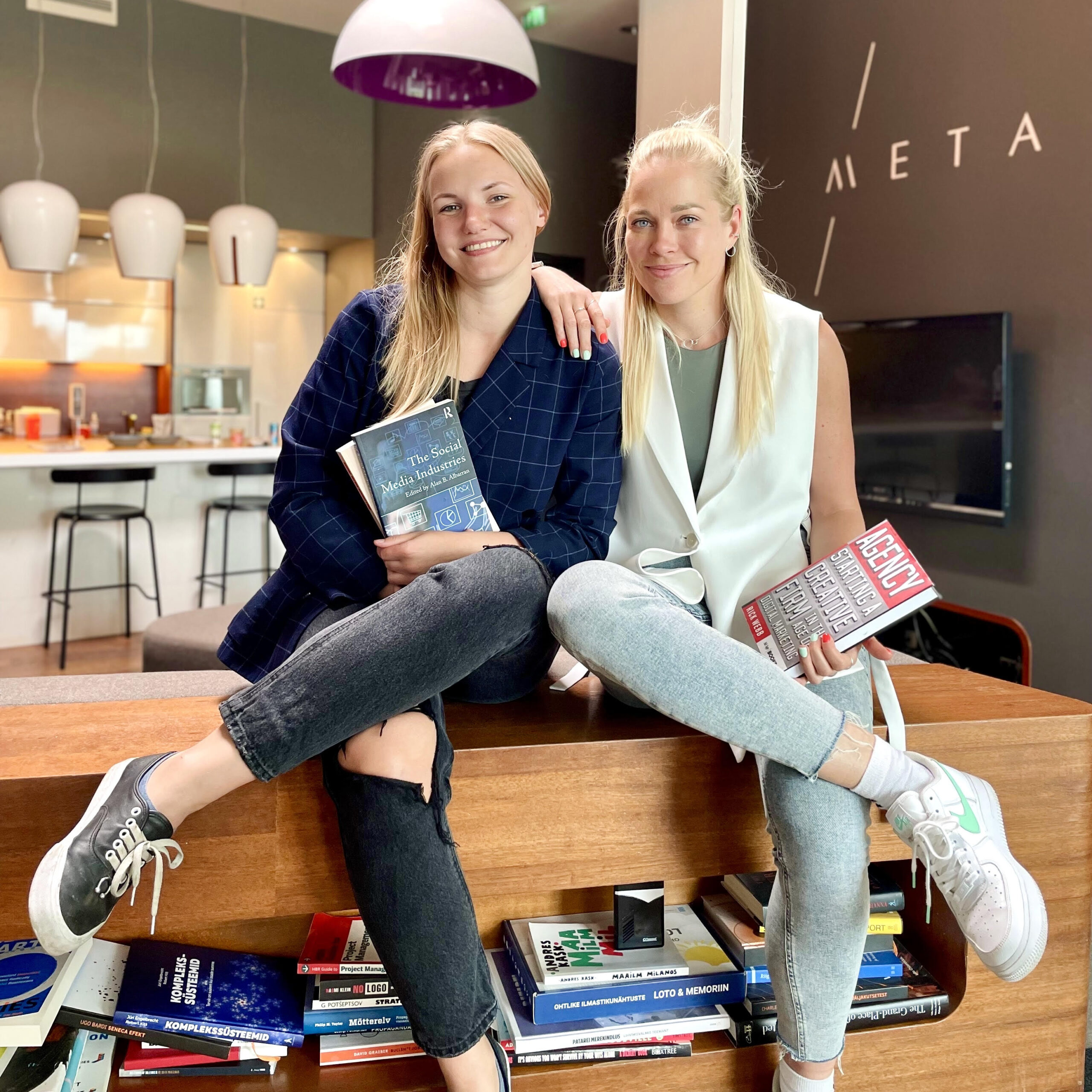
Digital communication should be seen as an organic part of well-thought-out modern PR, which must contribute to achieving corporate objectives. However, in practice, we often see a failure in noticing the opportunities that digital marketing can offer and that the basics of social media and digital marketing change so quickly that it is challenging to keep up with the latest innovations, tips, and recommendations.
That’s why we asked META’s digital marketing experts three important questions: Marketing Communications team Senior Consultant Karin Maandi and Consultant Helin Naska will help you navigate the digital and social media marketing landscape and decipher the benefits of the digital world, the most common mistakes, and the way forward.
1. What three benefits of digital marketing are often overlooked?
Karin: One of the key benefits is the ability to engage the customer better and drive their user experience. While other channels tend to be more one-way in communicating a company’s message or point of view, digital channels allow for a more two-way interaction, which helps to keep the consumer closer to the company. This way, it is possible to get immediate feedback and reactions and invite people to have their say on the product/service. But not only in terms of service and communication: clever marketers can use customer communication in marketing. Although customer testimonials and user-generated content are probably not alien concepts for any marketer, many companies today do not know how to exploit them in their marketing. In fact, this is free-generated content that marketers need to understand how to use in the proper channels. Yes, the GDPR does impose some restrictions, but this is nothing impossible.

Secondly, clever techniques in digital channels can give a quick kick-start to activities that might otherwise be scheduled in traditional channels. A ‘viral’ campaign doesn’t necessarily have to start on a digital medium, but the use of digital will speed up the spread. Good examples include a talented copy or outdoor posters created in a foreign country or physically located in another city, which spread far and wide within hours via social media channels. Often, people will share prominent ads organically, but it’s worth remembering that this process can also be consciously managed.
Helin: The plethora of different channels. From time to time, it can feel like new platforms are being created daily. In outdoor media, you can also use something “outside the box” as an advertising space, but in urban spaces, it is much more challenging to get these spaces than online. In addition, visibility is always higher online.
The diversity of channels is also associated with internationalisation. While different networks are in use in other parts of the world, certainly, there are platforms that remain the ones that connect us. It is possible to manage campaigns in all countries from one country in digital media.
“While different networks are in use in other parts of the world, certainly, there are platforms that remain the ones that connect us. It is possible to manage campaigns in all countries from one country in digital media.”
Karin: Digital media is where small businesses can get global attention. Even without a specific campaign, it’s much easier to gain visibility there than through traditional media. The key to solid visibility is a strong website and digital media presence. It is therefore an excellent channel for start-ups, which can achieve significant visibility on zero budget (or on a tiny budget).

But most importantly, knowing why it pays to be visible on social media or digital channels is essential knowledge, but it is even more critical to ensure that what you do there overlaps and is seamlessly aligned with your broader brand communication strategies.
Strategic communications that integrate digital with media communication—media communication, social media, advertising and more—all go hand in hand to support business growth. That’s why it’s good to manage all brand communications from an agency – with a deep understanding of media and messaging; we understand how different messages play out across various channels. That way, you can be sure that the entire brand messaging is coherently managed.
2. Three mistakes you’ve noticed in Estonia’s digital marketing or social media world?
Karin: Firstly, the underuse of keywords. I’ve noticed that many people start SEO by picking a few keywords, working with them, and feeling like everything they need is done. Keywords should be constantly monitored and even changed – it’s not enough to put keywords in place and then revisit them in three years. It’s worth looking at competitor keywords, doing background work, and keeping them updated. 93% of the online experience starts with the search engine.
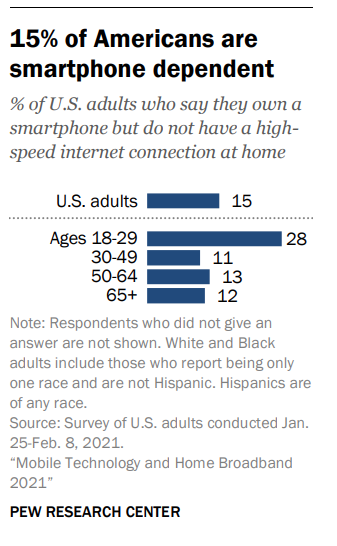
Secondly, I would suggest thinking more about what happens to websites after the marketing activity. One of the mistakes is not thinking about how to ‘convert’ visitors into customers. Here, it is worth asking yourself some questions: what keywords are visitors coming from? What will they do next on the page? In the case of an e-shop, the keyword is the sales pitch: will the visitor get something for free, or will they be greeted with a special greeting, such as a video?
Thirdly (though less so): the mobile user tends to be forgotten. The number of people using mobile devices to go online is constantly growing. It is worth considering colours, volumes, and the environment. So, in the context of a digital campaign, it is essential not to forget to increase the mobile advertising budget but to pay more and more attention to it consciously.
“So, within a digital campaign, you should certainly not forget to increase the mobile advertising budget; rather, it should be consciously given more and more attention.”
Helin: One observation, which is rather peculiar to Estonian marketers: often, there is a lack of courage to test new platforms.
There are a lot of networks and environments that are entirely undiscovered in the Estonian context. One of them is Reddit, which is used by young people in Estonia but is not yet thought about in the context of marketing and communication. However, new channels are particularly favourable for first-timers, especially in the start-up phase—no competitors and a higher chance to stand out.
Of course, one should not do something for the need of doing it, but if you notice that a friend or a mother, for example, is active in a new channel, it’s a sign that it’s the right channel to reach them. It’s worth a try. A user may already be drowning in ads on widely used channels such as Facebook!
“There is often a lack of courage in Estonia to test new platforms. There are a lot of networks and environments that are still completely unexplored in the Estonian context.”
3. Where will digital marketing be in five years?
Karin: Augmented reality combinations will probably be more available and used more avidly in marketing campaigns. This could mean more interactive advertising and new experiences for the customer—for example, the possibility of 3D viewing on the phone. Voice-activated driving is undoubtedly a keyword. Maybe even dare we say that 50% of the searches in the world will be voice-driven.
In addition, I believe that content will change significantly. People have less time to concentrate: we need to think about how to get the messages across concisely and what kind of content requires the least time and energy from people. I believe this principle will become even more rigid on a channel-by-channel basis, and the length limits for videos will also become shorter.
Helin: I agree that in digital and social media, we need to be even stronger in the future in the channels people use. The more convenient life is for the consumer, the better. Everything we don’t have online yet will move to the Metaverse.
Recommendations: where do you get inspiration and keep up to date with the constant changes?
Karin: What’s great about META is that we have experts in their field, the top of the marketing and communication world—working with them guarantees that you will learn every day. Secondly, we have industry-leading clients and client-facing managers, who need to keep up to date with the latest developments daily to provide excellent advice, but who also offer a diverse range of knowledge themselves. On digital marketing, I dare to recommend: HubSpot’s blog. For good visual reviews, check out Social Media Today.
Helin: I try to be open-eyed—to see new ideas and channels in everyday life. When I see a friend spending hour a day on Reddit, it’s clear that there are more like them.
For everyday social media use, I recommend LinkedIn: you can find a lot of useful material for professional use and exciting case studies and thoughts from experts there.
META WAS AWARDED ‘PR AGENCY OF THE YEAR 2022’ TITLE
META Advisory was awarded the title of ‘PR Agency of the Year 2022’ at the oldest and most important marketing and advertising competition in Estonia, receiving two gold, two silver and two bronze awards for outstanding campaigns.
At the Kuldmuna 2022 creative competition party held at Põhjala factory on 13 May, awards were given to the most talented Estonian marketing, communication and advertising agencies and clients and their collaborative creative works. META, which won two gold, two silver and two bronze eggs, was awarded the title ‘PR Agency of the Year 2022’.
“While we strive to do gold standard work every day, there are some projects and campaigns that resonate more than others or have been particularly effective in helping clients achieve their strategic goals,” commented META partner Andreas Kaju. “This is the second time in the last four years that we have been titled ‘Agency of the Year’ and we can be sure that it will not be the last.”
META thanks its clients for the opportunity and trust to create new solutions where there is no previous case study. “We also send our congratulations and thanks to our good partners, because only with you it is possible to create campaigns that really work,” said Kaju.
“While we strive to do gold standard work every day, there are some projects and campaigns that resonate more than others or have been particularly effective in helping clients achieve their strategic goals.”
The jury selected the best entries in each category from a total of 822 entries. The PR jury included Ann Hiiemaa, META’s New Business Development Manager. In addition to her, there were six other members of the PR jury, including top people in their field from agencies, clients, both public and private sectors.
The organiser of the Golden Egg competition, The Association of Marketing Professionals (TULI), is an association of all marketing professionals whose mission is to raise awareness of the various aspects of marketing among local businesses and Estonian society as a whole. Kuldmuna, now in its 24th year, is therefore the oldest and most important advertising competition in Estonia.
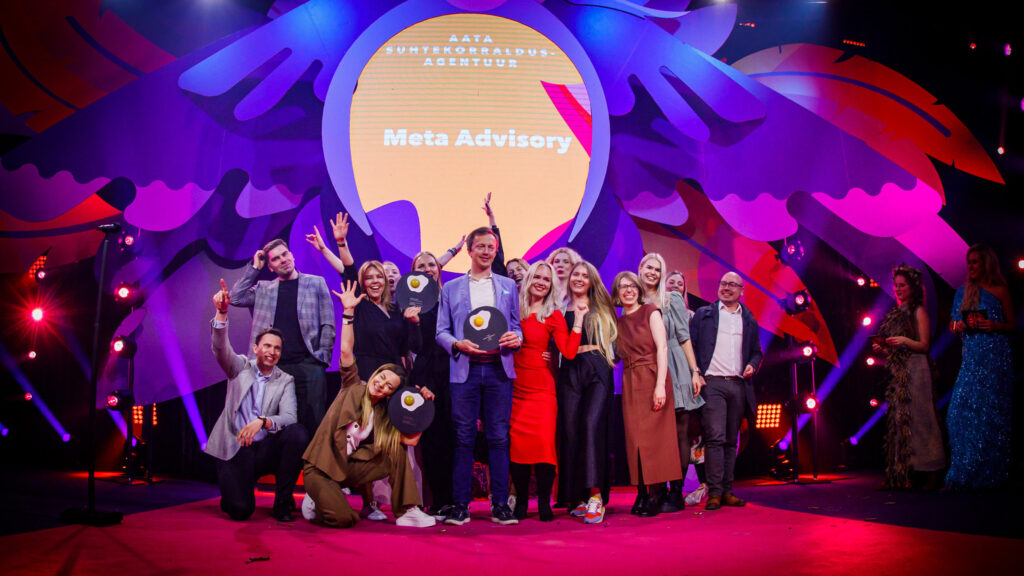
AWARDS
🥇 GOLDEN EGG
- Public Sector Communication
Digitally Wild press trip: how €45 000 brought €500 000 worth of media coverings
Client: Enterprise Estonia
Team: Mirjam Mäesalu, Maarja Karmin, Anni Türkson
. . . . . . . . .
- Influencer Marketing
Joel Ostrat’s Maestro burger in McDonald’s restaurants
Client: Premier Restaurants OÜ/McDonald’s Eesti
Team: Helin Naska
🥈 SILVER EGG
- Corporate Communication
How Tele2 cancelled its Christmas campaign
Team: Ann Hiiemaa, Lily Mägi, Laura Põldma
. . . . . . . . .
- Influencer Marketing
Dexcom Warriors
Client: Dexcom, Inc.
Team: Cairit Eit, Andreas Kaju, Rainer Laurits
🥉 BRONZE EGG
- Integrated Communication Campaign
Ivo Nikkolo rebranding communication
Client: Baltika AS
Team: Helin Naska
. . . . . . . . .
- Event Communication
Exhibition “Hirmus”
Client: Balti Jaama Turg/Astri Grupp
Team: Riin Härma, Kert Kask
Gallery
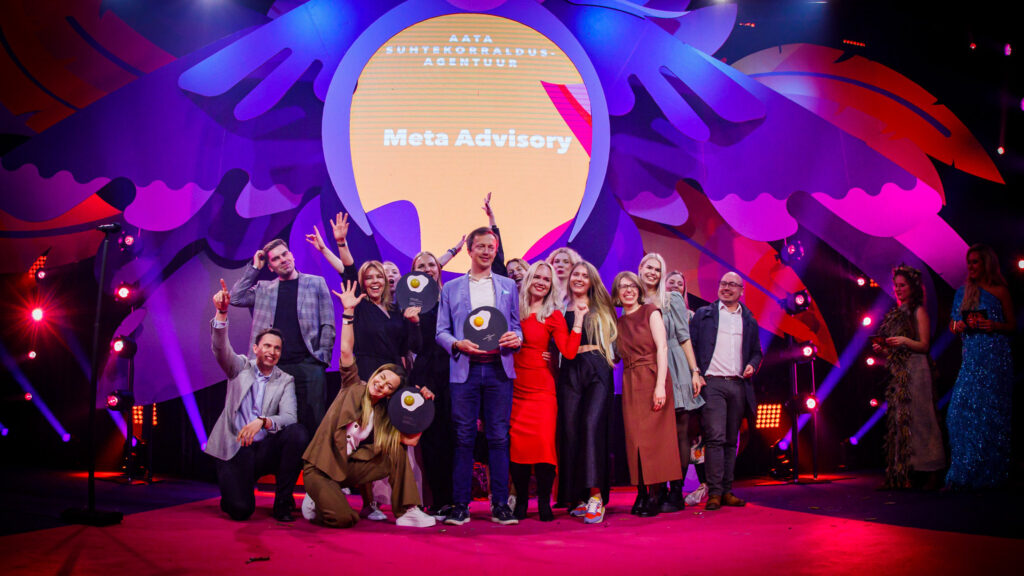
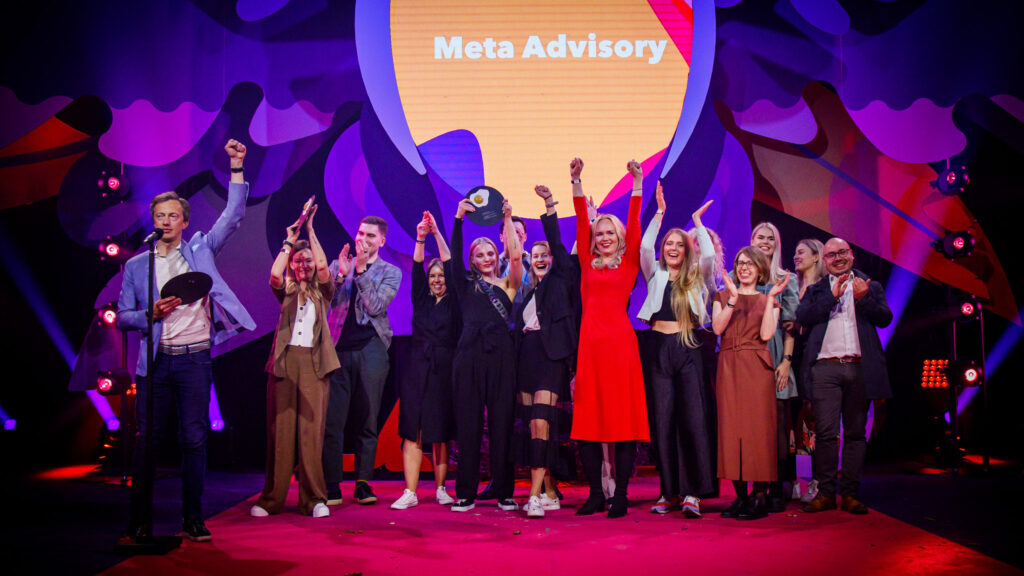
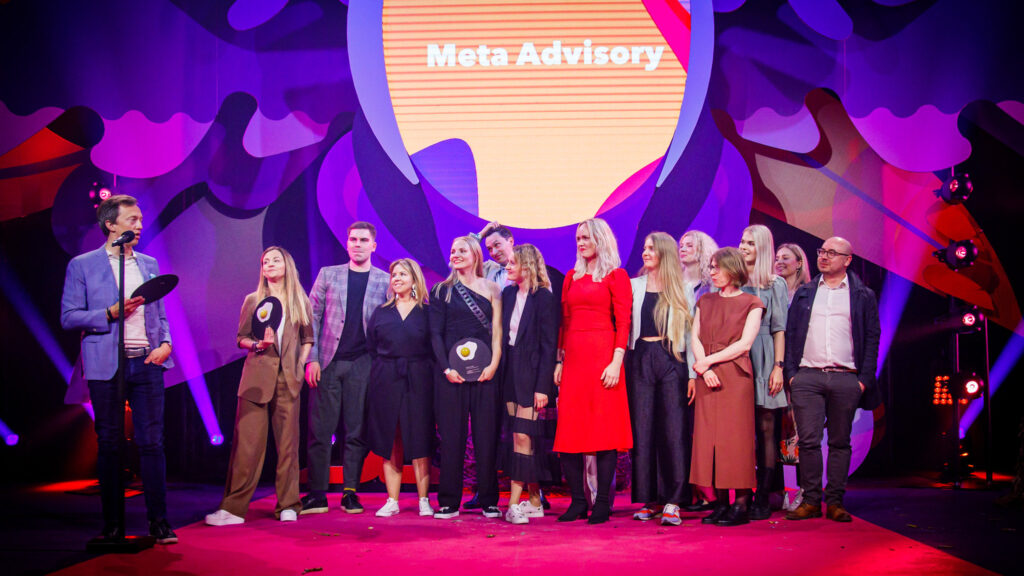
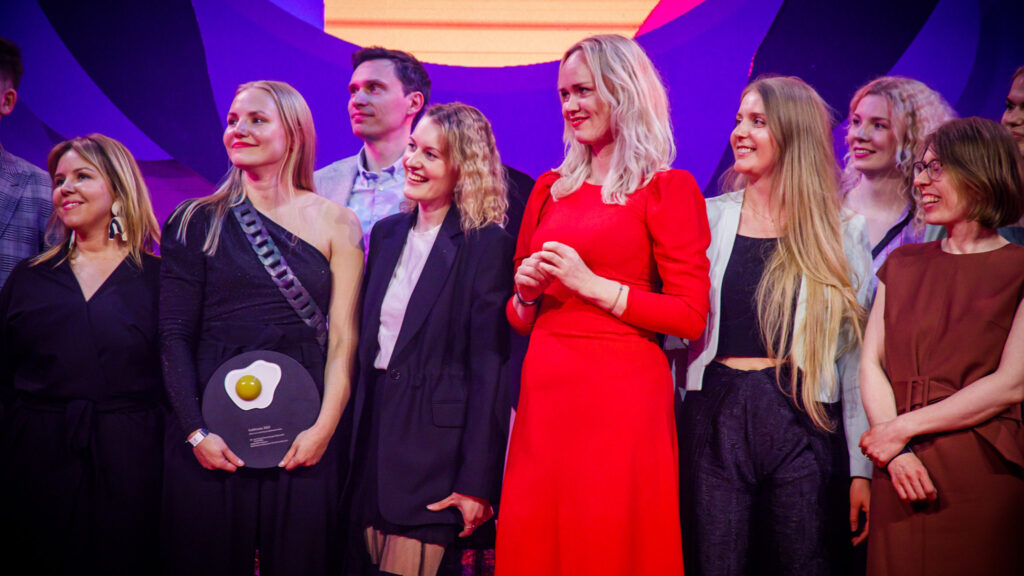
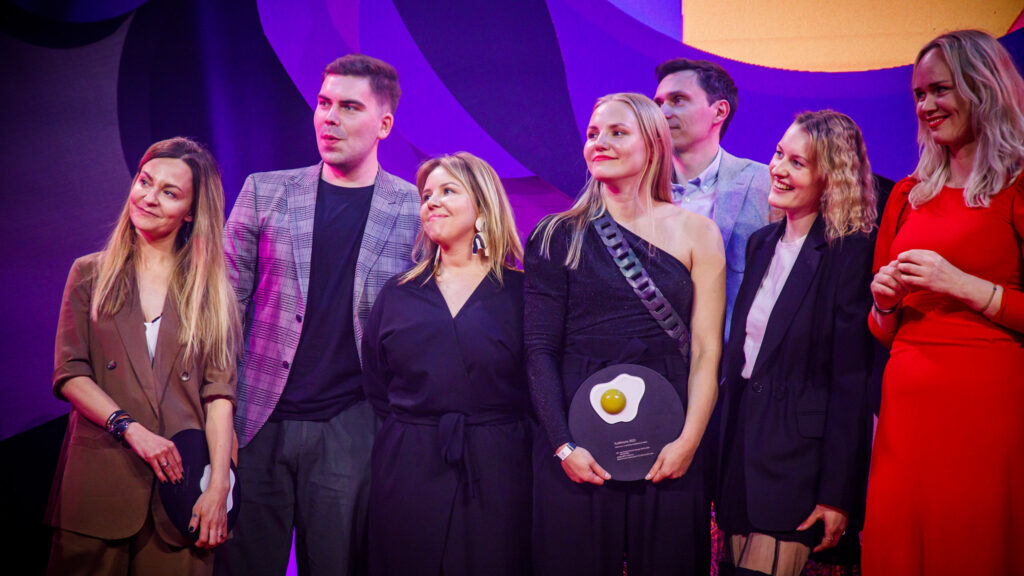

ANDREAS KAJU: HOW TO COMMUNICATE IN TIMES OF WAR?

Andreas Kaju, the founder of META Advisory, shares his recommendations on what to keep in mind when it comes to marketing communications in the context of the ongoing war in Ukraine.
1. In general, war references in brand communications should be avoided (an example: Shop X is sympathizing with the Ukrainian people; thus, it decides to change its social media profile picture). Or at least—if in doubt, don’t do it. Often such communication, regardless of the good intentions of the doer, is disrespectful of people’s real suffering, devaluing it. Clever copywriting won’t change that. This can sound harsh to the worried Estonian marketing experts, but your words are worth nothing in this situation. Instead, do something as we have real opportunities for that (introduced below).
2. Referring to war when used as an argument to sell products or services to people should be completely ruled out. If a company makes such claims in conjunction with a bargaining campaign, I would advise journalists to ensure if and where the company is donating. In any case, this should be ruled out. If you want to help, then help, but don’t tell the customer that I will help if you buy more of my products and services at such-and-such a price in the future.
Referring to war when used as an argument to sell products or services to people should be completely ruled out.
3. We will treat companies that publicly announce their donations to organizations and institutions approved by the Ukrainian state (or Estonia) with goodwill. Those who directly and authentically help the people in need deserve society’s appreciation. The actual cost and new risks will follow real aid in today’s world. In addition, courageous steps by companies help mobilize other supporters in society.
4. I would also recommend contributing to humanitarian aid. Organizations in Estonia have the experience and skills to use the money to ensure its impact. However, direct donations are currently the most effective (I believe that the Ministry of Finance will soon resolve the issues involved—so that donations can be made without paying income tax).
5. Many companies can also support by donating their products. This is entirely appropriate—before doing so, it is worth making sure which products meet the standards Ukraine needs and can use (these lists are available), and it is also worth consulting the Red Cross. In addition, the NGO Estonian Refugee Aid centralizes assistance to war refugees, and the Social Insurance Board should also be kept informed.
* Certainly, the preceding does not apply to the party at war. They are, of course, allowed to use the power of the word and the image to the maximum extent possible. In times of war, production is readjusted to what is needed at the time.
Internship at a government relations and PR agency through the eyes of #METAIQ interns
Thinking about doing a traineeship but not sure where, what and why? Would you like to know what an internship in government relations and PR agency is like? Let us help you clear your mind—previous participants of the METAIQ internship programme looked at their summer internship experience in the META team.
An internship is a unique opportunity to investigate a field of interest and put your theoretical knowledge to the test in practice. In 2022, for the third summer, META will organise the #METAIQ internship programme, where future PR talents, government relations experts, or digital and multimedia professionals will have the chance to roll up their sleeves and take a step towards their dreams.
Clearly, the journey from school to the first professional traineeship is not always easy. We know from our own experience that there are many questions that can arise when it comes to choosing a traineeship, such as: what to consider when choosing a traineeship? How to get the most out of the placement? Who would be suitable for an agency placement?
Our own #METAIQ trainees can provide the best answers and the most in-depth insight into these questions. We’ve met with many talented young people throughout the years, however, this time we spoke to four of them and asked them to look back on their experience.
Applications for the 2022 #METAIQ internship programme closed on 17 April!
Karolina Kadak | marketing communications intern 2020

“An internship at an agency is a great foundation for an exciting career. It’s not easy to find such a variety of projects, opportunities to broaden your horizons, and a developing working pace.”
Read about Karolina’s internship experience
What is your professional background?
I am a student of Journalism and Communication at the University of Tartu. I have finished my Master’s degree by now, but I did my traineeship at META after my second year of undergraduate studies. Before that, my primary professional exposure to journalism was as a summer reporter position at Tartu Postimees a year earlier. I continued to write stories for them a co-author. Prior to the internship, I already had some association with communications as a Tartu Student Days’ media manager.
What makes the internship at the agency unique for you?
An internship at an agency is an excellent foundation for an exciting career. It’s not easy to find such a variety of projects, opportunities to broaden your horizons, and a developing working pace. What I liked most about the internship was the exposure to a diverse range of clients, projects, and tasks – the experience, knowledge, and courage I gained afterwards were much more remarkable. I felt as if I had gained the knowledge of several traineeships in a month.
What exactly did you do during your traineeship? Can you name a project or task that you were involved in at META that you enjoyed?
During my traineeship, I contributed to the development of communication plans, wrote press releases and other media texts, organized media lists, and monitored and summarised media coverage of clients. In addition, I was able to accompany my supervisor to client meetings, which gave me a fascinating insight into how agency-client cooperation works and how a project goes from brief to a fierce campaign. I can confidently say that I enjoyed all the tasks entrusted to me during my internship at META. The sparkle that came out of my training gave me the courage and the confidence to pursue my career in the communications field, working in an agency – today, I am a project manager in the PR team at creative agency Taevas Ogilvy.
What would you recommend to a student (in your field) who is still choosing a placement – what are the criteria for choosing a placement? What to consider when choosing a placement?
Try to get as broad a picture as possible of the opportunities in your field through internships. For example, if you are studying journalism and communication, I would recommend trying out both sides of the profession, regardless of where you initially see yourself in the future. The experience you gain in editorial work will definitely be helpful when you work in communication and vice versa.
I would recommend trying a traineeship in both the private and public sectors in communications. This way, you will increase your knowledge and experience and learn more about yourself through each placement. I can tell you from my own experience that, by adopting this strategy, even a newcomer to the profession will have a pretty good overview of their field by the time they start their first job, which will be hugely valuable in their future work.
Share three tips on how to get the most out of your traineeship?
1. Do a bit of preparatory work before starting your traineeship – find out more about the company/institution you’re going to. Find out what they’ve done that stood out and what their most exciting projects have been, and if possible, look at case studies and media coverage. Doing your homework beforehand will make it easier to settle in and undoubtedly help build mutual trust.
2. Think about your goals before the placement – in what areas and tasks do you want to be challenged? What contacts do you want to make? How could the placement develop your knowledge and skills? Setting goals helps you get the most out of your placement and helps you give your best, which is one of the biggest learning accelerators.
3. Appreciate your supervisor and the time they dedicate to you. Take the time to work through their guidance and feedback thoroughly – this will help you develop immensely and, in doing so, will build the confidence that will lead to exciting opportunities in the apprenticeship and help build a solid foundation for your career. Thank you, Riin!
Eero SIld |Government Relations intern 2021
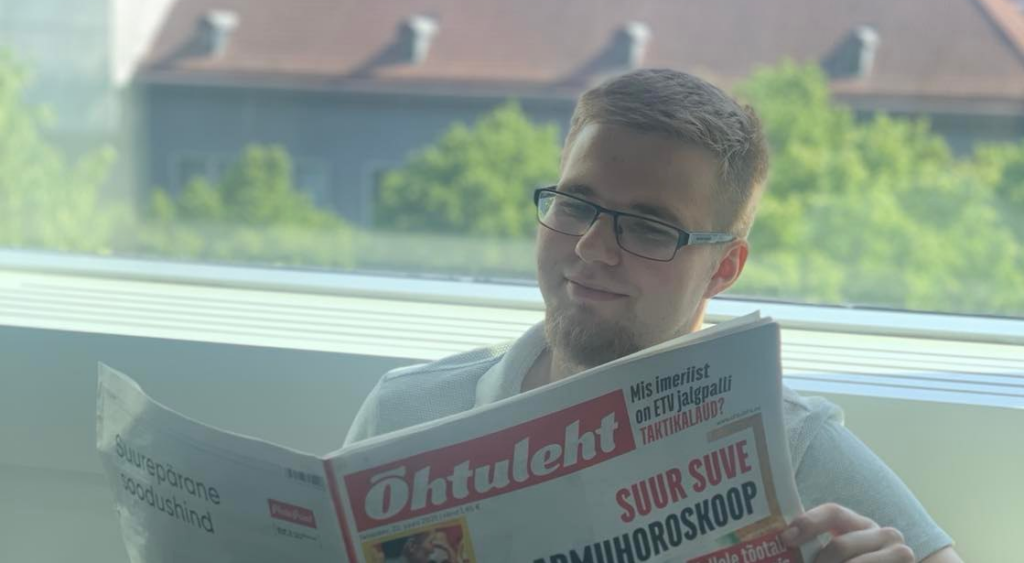
“Personally, I try to try something completely new every year – something related to my field of study, of course – so that I have a better understanding of what I want to do after my studies and what I’m really interested in.”
Read about Eero’s internship experience
What is your professional background?
Political Philosophy and International Relations, I have previously interned at the Ministry of Foreign Affairs.
Why did you choose META as your traineeship?
Purely out of personal interest: I had no idea what a PR agency did before working at META, and META was recommended to me by friends who had interned there before.
What makes an internship at an agency exciting or unique for you?
Being able to solve problems and perform tasks that are also done by paid staff – then a) I feel like a full member of the team and b) the internship also feels more rewarding because I get to see what the job is really like.
What exactly did you do during your traineeship? Name a project or assignment you worked on at META that you enjoyed?
I wrote reports and market research on new trends in the PR world, did translation work, and researched background information for a client. In addition, I produced monthly client reports. I enjoyed most gathering information and writing reports, as it was never routine. I felt that my work was valuable (bravo to META partner Andreas, who was very good at explaining the purpose and necessity of the tasks to the trainee).
What are the three biggest lessons you took away from your internship in government relations and PR?
The importance of the working environment – I felt valued by the employer at work, which also motivated me more. From the Coca-Cola in the fridge to the team events – it always felt like I was part of something bigger.
For PR work, it’s about character, not the professional background. I think that everyone can find a place in this field due to so many different types of clients and projects. But I suspect that psychologists and sociologists may have a particular advantage because I feel that PR is more about knowing people than products. Contacts are the most important thing when you’re doing relational work. It is probably impossible to set up a PR agency and find clients without a reputation and contacts.
What skills did the internship develop in you the most?
Prioritizing tasks and time planning. Also, the ability to say ‘no’.
What did your internship at META teach you about your own position?
It taught me that I don’t like routine work.
What would you recommend to a student (in your field of specialisation) who is still choosing an internship – what are the criteria for choosing an internship?
It’s worth thinking about what the placement will give you – whether and how much you will develop during the internship. For example, I try to do something completely different every year – something related to my field of study, of course – to have a better idea of what I want to do after my studies and what really interests me.
In three words, describe the atmosphere at META.
Positive, friendly, and mega-cool. I am grateful to the whole team for this experience.
Share three tips on how to get the most out of your internship?
Socialize as much as possible with colleagues (but not at the expense of work!).
When you run out of tasks – and this can happen – go and ask for more. At least in my experience at META, you don’t have to limit yourself to your supervisor – you can ask anyone. It was fascinating to see the PR side of things besides the government relations side. I think it fulfilled the whole internship experience.
And another important thing: if you don’t like something, say so. Really.
Keneli Pohlak | Marketing Communications intern 2021

“All the more reason for me to be delighted to see the client’s final advertisements and visuals after the internship – both in urban spaces and in digital media. That’s exactly when I had the great feeling that the ideas that had been in my head and were being finalised together with my colleagues were being realised!”
Read about Keneli’s internship experience
What is your professional background?
When I started my internship at META, I was just finishing my first year at the Faculty of Economics at Tallinn University of Technology. I majored in Business Administration and, more recently, specialized in Marketing at the beginning of 2022. Therefore, from an academic point of view, I did not have much experience in marketing communication. However, just before my summer internship, I had applied for the marketing team of the solar car project Solaride (now the educational program Solaride Academy) in the spring. As a result, I was selected to the marketing team, where I made a giant leap in my professional background with the best mentors in my field.
However, I believe that having graduated from Väike-Maarja Gymnasium with a gold medal, while at the same time having been very active in student council activities as president and in several competitions and contests, I gained the experience to successfully take my first steps in the marketing world. Time planning, critical thinking, prioritizing activities, and finding solutions are essential keywords that will also come in handy when working in marketing.
After the internship, I was hired to work as a social media specialist to SPARK Studios. I’m sure that my internship was a great incentive to start working there because I fell in love with the thrill and pain of agency work!
Why did you choose META for your internship?
I didn’t have much of an agency background when I applied. I had heard about META’s work culture and projects from my cousin Kristi, who worked as a senior consultant about three years ago. I came across META’s internship opportunity advertisement on Facebook several times. I thought it was a sign to apply – so I checked the website and social media platforms for more information about the agency. I made a decision and finally used it. As a first-year student, I didn’t have high expectations, but the whole process went well!
Why did I choose an agency instead of a specific company’s marketing department? Definitely because of the broad focus. I wanted to get an overall experience, and that’s what the META internship provided. During the day, for example, I had to deal with a company in the logistics sector and the fashion sector, write an article in the food sector, and later work on a campaign for a group of shopping centres. Broadening my worldview and dealing with different companies was one of the best experiences during the traineeship.
What exactly did you do during the internship? Name some of the projects you worked on at META that you enjoyed.
During the internship, I was exposed to a wide variety of issues. For example, drafting media pitches for companies, coming up with campaign ideas, making presentations for clients, and writing content marketing articles and press releases. I hadn’t been exposed to many of these tasks, but the tutors were always beneficial and supportive. My two supervisors – Helin and Riin – were the ones who mainly gave me assignments, but when I felt I was getting more done, I would also ask other assistants for assignments.
The most exciting tasks were probably two large-scale campaigns. For both of them, I was more in the brainstorming phase at META, formulating the final ideas, so I didn’t get to realise them myself. This made me happier to see the final version of ads and visuals after the internship – both in outdoor advertising in digital media. That’s precisely when I had the pleasant feeling that the ideas that had been in my head and were being finalised with my colleagues were being realised!
Who would you recommend an internship at the agency to?
I would recommend a traineeship at an agency to young people eager to learn and ready to work in unexpected situations. To a young person who wants to gain different experiences by dealing with various clients and who wants to put what they have learned to work for them. For a young person who is not afraid to make mistakes but is willing to try. For the young person who wants to combine new creative solutions with solutions that have worked before.
It is certainly not worth being afraid of doing an internship. If you don’t try, you won’t know what works!
Share three tips on how to get the most out of your internship?
1. If you feel you could do more and want to try more during your traineeship, don’t be afraid to ask other colleagues for more. The great thing about META was that while on a day-to-day basis I was dealing with clients whose relationship was managed by my mentors, other colleagues had different clients and activities to try out whenever possible. So, once again, it broadened my horizons and allowed me to peek behind the scenes of other businesses in the sector!
2. Go to the office when possible and spend time with others during your lunch break. My internship experience wouldn’t have been like this if I’d spent all my time in my home office. You get to participate in so many eye-opening discussions and find fascinating information you might not have heard about before. But, of course, the main thing that is also constantly talked about at university – networking and contacts are essential! PS! Keep in touch with your fellow trainees – I never thought I’d find a good friend during my traineeship, and I’d still be exchanging ideas with her.
3. Offer your youthful ideas and share your own experiences. I had a fun situation. We were in the kitchen with a senior consultant, and we talked about posting on LinkedIn. One of META’s clients needed consultation on this very subject. I had recently spoken to a mentor from the Solaride student project before—about managing Solaride’s LinkedIn account—and the solutions that worked in this case. She also shared case studies and videos on how to work on the platform. When the topic came up in META’s office, I immediately shared my ideas and knowledge with the senior consultant – and even for her, a few ideas came as a surprise. So it was a real success! Plus, nothing is ever fixed in marketing—always offer all your ideas to find out the best ones.
Saskia Bergmann | Government Relations intern 2021

“One of the most surprising new insights was how positive government relations work could be. I had assumed—and sometimes experienced—that government relations were mostly about influencing policy through the private sector. Still, in many ways, government relations is also about helping firms adapt to new policies and be at the forefront of change.”
Read about Saskia’s internship experience
What is your professional background?
I am studying political science at the University of Amsterdam. Before META, I did an internship at the Ministry of Social Affairs. I am very interested in the view of political developments as a shaper of society; thus, how we achieve change through politics. The META internship was a great place to discover this.
What exactly did you do during your internship? Name a project or task you were involved in at META that you enjoyed?
At META, I produced a review of EU Green Deal policies and their impacts. At first, it seemed like a simple overview, but it turned out to be quite challenging and a lot of fun to process so much specific terminology and complex text!
I learned a lot about how the European Union works and got some excellent ideas about sectors to invest.
What are the three biggest lessons you took away from your internship in government relations and PR?
The biggest lesson was professionalism and regularity. Assignments had to be completed quickly but without sacrificing spelling, the visual aspect of the document, etc. One of the most surprising new insights was how positive government relations work could be. I assumed—and sometimes experienced—that government relations were mostly about influencing policy through the private sector. Still, in many ways, GR is also about helping firms adapt to new policies and be at the forefront of change.”
What skills did the internship develop in you the most?
In addition to the regularity mentioned above, I became much more familiar with the terminology used in government agencies, the documents, and the processes to follow. One of the most important skills was synthesizing complex texts into concise ones. The ability to be independent and entrepreneurial, think ahead about projects, and even have the courage to ask for new projects for myself was also important.
Who would you recommend an internship at an agency to?
I would recommend a traineeship at META to everyone! Even if it turns out that it’s not quite what you want to do, the experience itself is so valuable, educational, and fun that there is definitely no regret.
In three words, describe the working environment at META.
The META working environment is fun, open, and challenging.

NB! Microsoft on loobunud Internet Exploreri arendamisest ning sellele uuenduste tegemisest ja ei soovita antud internetibrauserit turvanõrkuste tõttu kasutada. Internet Explorer ei toeta enam uusi võrgustandardeid ning antud veebilahendus ei tööta siinses brauseris korrektselt.
Palun lae alla mõni moodne veebilehitseja:
The website uses cookies. Cookies are required for your convenience and web statistics. By continuing to use the website, you agree to the terms of the privacy of cookies! You can see the terms of the privacy policy in here.



